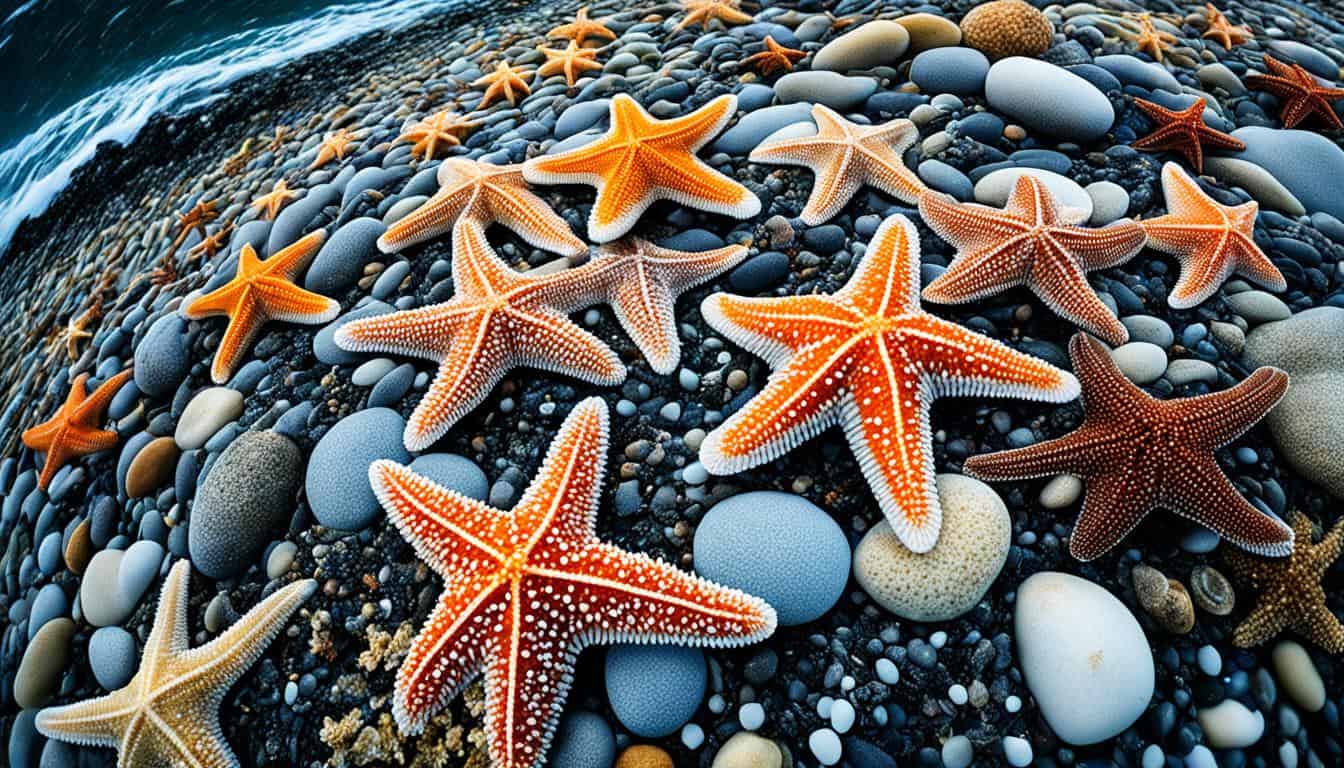Starfish, also known as sea stars, are fascinating creatures living in various ocean environments. They belong to the phylum Echinodermata, which also includes sea urchins and sand dollars. With almost 2,000 species, starfish come in many shapes and colors. Knowing where they live helps us understand their behavior and their importance in the ocean.
This article will dive into the different places starfish call home. We’ll look at the unique conditions that support their life. You’ll learn about the marine ecosystems where starfish live and their important roles in these environments.
Introduction to Starfish Habitats
Starfish are fascinating creatures that belong to a group called echinoderms, meaning “spiny skin.” They have hard, protective skin that helps keep them safe from predators. Knowing where starfish live is key to understanding their role in the ocean.
Understanding Echinoderms
Echinoderms include starfish, sea urchins, sand dollars, and sea cucumbers. These animals have special features like radial symmetry and feet that move with the help of a water system. They live in different places in the ocean, playing important roles in their ecosystems.
Starfish Classification and Diversity
There are about 2,000 types of starfish, showing a wide range of colors, sizes, and where they live. Some starfish can change color to hide, while others stand out with bright colors. This variety lets them live in many ocean areas, from shallow waters to deep sea.
Where do starfish live?
Starfish live in many different places under the sea. They can be found in shallow coastal areas and deep in the ocean. Knowing where to look for them helps us understand the health of our oceans.
Global Distribution of Starfish
Starfish live in oceans all around the world, from the Arctic to the Southern Oceans. They like places with the right temperature, salt levels, and food. You can find them in shallow coastal areas and some even go deep into the ocean.
Depth Ranges of Starfish
Starfish can live in many depths of water. Some like the sunny shallow areas where plants grow. Others live deep in the dark ocean. Knowing where they live helps us learn more about these amazing sea creatures.
Starfish Habitats in Detail
Starfish live in many marine habitats, each with its own special conditions. These places help them survive and play important roles in their ecosystems. Learning about these habitats helps us appreciate how starfish adapt and the ecosystems they live in.
Tidal Pools
Tidal pools are shallow areas along the shore that fill with water at low tide. They are perfect spots for starfish to hunt, with lots of barnacles and small creatures to eat. Despite the changing water levels and temperatures, many starfish have learned to live here.
Rocky Shores
Rocky shores are key places for starfish too. They stick to the hard rocks, which helps them stay safe from big waves and currents. In these spots, they can hide in cracks and eat the many creatures living there. The variety of life on rocky shores shows how important these places are.
Coral Reefs
Coral reefs are some of the most lively places in the ocean for starfish. They are full of food like sea urchins and sponges. The reefs also protect and help starfish breed, making them perfect for many starfish species.
Seagrass Beds
Seagrass beds are vital for starfish because they are full of life and have calm waters. These areas have lots of food, like mollusks and crustaceans. Starfish can hide in the seagrass, making it easier to hunt. Keeping seagrass beds healthy is key for the ocean’s balance.
Kelp Forests
Kelp forests are another special place for starfish. These underwater forests are full of life and have tall kelp that provides shelter. The variety of food here helps starfish communities thrive. Seeing starfish in these places shows how all marine life is connected.

Marine Ecosystems for Starfish
Starfish are key players in marine ecosystems. They are not just interesting creatures but also vital for keeping the balance in nature. By eating mollusks like clams and oysters, they help control their numbers. This stops these species from taking over and causing harm to the environment.
Interactions with Other Marine Life
Starfish have a big impact on the ocean’s ecosystem. They are eaten by big fish and sea turtles, making them a crucial link in the food chain. As a keystone species, they greatly affect the variety and number of other sea creatures.
Role in Ocean Health
Starfish help keep the ocean healthy. Their eating habits help recycle nutrients, which is key for keeping life diverse. Healthy starfish populations mean a healthy ocean, showing how important they are for the ocean’s well-being. Understanding their role helps us see why we should work to protect them.
FAQ
Where do starfish live?
Starfish live in all the world’s oceans. This includes the Arctic, Atlantic, Indian, Pacific, and Southern Oceans. They can live in both warm and cold waters, from shallow to deep-sea floors.
What are the main habitats of starfish?
Starfish live in many places like tidal pools, rocky shores, coral reefs, seagrass beds, and kelp forests. Each place offers different living conditions and resources.
How deep do starfish live?
Starfish live at different depths. Some are found in shallow coastal waters, while others live deep in the sea. This depends on the starfish species and its home.
What role do starfish play in marine ecosystems?
Starfish are important in marine ecosystems. They eat mollusks like clams and oysters. This helps control their numbers and keeps the ecosystem balanced.
Can you find starfish in freshwater environments?
No, starfish live in saltwater only. They are not found in freshwater areas. They are marine animals, adapted to saltwater.
Are all starfish species the same?
No, there are almost 2,000 starfish species. They come in many shapes, colors, and like different homes. This shows how adaptable they are in the sea.
How do the living conditions of starfish differ in various habitats?
Living conditions for starfish change a lot from one place to another. For instance, tidal pools and coral reefs are very different. They affect what food is available, who the predators are, and the water conditions.







